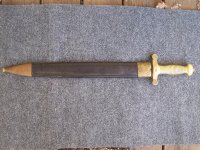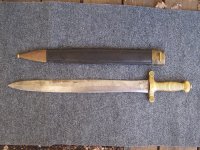My dad brought this French Model 1831 sword back from Europe after WWII. It has been sitting in a closet ever since, except for an occasional showing to friends and family. Last week my mother gave it to me.
The sword and sheath are made of brass, steel, and leather. There is a build-up of dirt and other stuff on the handle and blade. I would like to give the sword and the sheath a coat of Renaissance wax and then hand buff it off. Will that clean and protect them without doing any damage?
Would wiping it down first with mineral spirits be a good idea? Bad idea?
Thanks for any help.
The sword and sheath are made of brass, steel, and leather. There is a build-up of dirt and other stuff on the handle and blade. I would like to give the sword and the sheath a coat of Renaissance wax and then hand buff it off. Will that clean and protect them without doing any damage?
Would wiping it down first with mineral spirits be a good idea? Bad idea?
Thanks for any help.
Attachments
Last edited:


